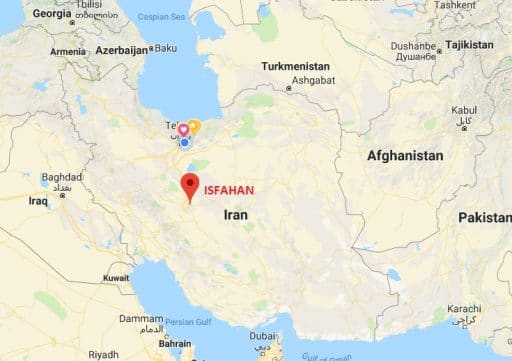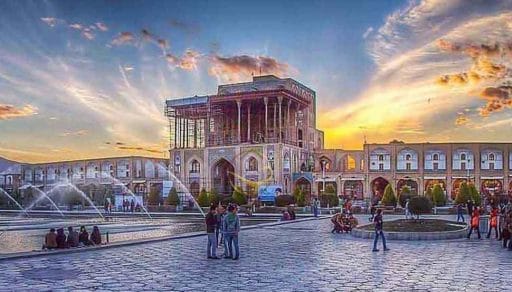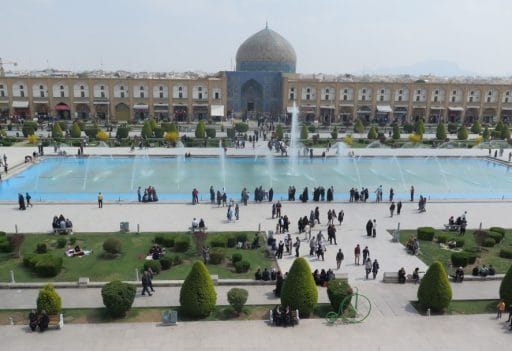Introduction
Among the cities of Iran, for sure Isfahan is like a piece of jewelry that despite of the historical instability in the area has still retained its luster and glory throughout the centuries.
Isfahan is a city in center of Iran where known for its Persian architecture. In the huge Naqsh-e Jahan Square is the 17th-century Imam (Shah) Mosque, whose dome and minarets are covered with mosaic tiles and calligraphy. Ali Qapu Palace, built for Shah Abbas and completed in the late 16th century, has a music room and a verandah overlooking the square’s fountains. Sheikh Lotfollah Mosque is known for its intricate tiling.

location in Iran map
highlights
The City of Four Seasons
Isfahan is in the center of Iran inside the plains stretching along Zayandeh Rood River. The city location is in a mountainous area in the center of the Iranian Plateau. this city stretches from the snowy Zagros Mountains in the West to the East and Isfahan is also in North-central deserts of Iran. There exists a variety of climatic conditions in the city thanks to regions with different altitudes.
Generally, as the altitude falls from Western city to the Eastern, the area temperature increases together with the decrease in the amount of rainfall.
Spring begins in late March with the trees in full bloom, summer usually starts in late June. The city greets fall color in late September with the leaves falling off the trees and finally winter starts in late December. Among all the seasons and months, Isfahan is in its perfect situation in May. Isfahan has full sunlight and is sunny three fourth of a year.
A museum where people live
With its old history and numerous monuments, Isfahan is an exemplary city in the world.

Ali Ghapoo Palace
According to the French author, Andre Malraux, only Florence and Peking are comparable to Isfahan. The historical monuments of Isfahan comprise a collection of the finest examples of the various styles of Persian architecture . The quality and quantity of these works of art are great and they are masterpieces of the post-Islamic Iranian architecture .
some of the most important historical attractions of this city are: various types of domes, tile works, plaster works, frescos wall paintings and calligraphies . These works reveal the religious beliefs

Naghsh-e Jahan Square
of their creators and fascinate the visitors.
A World of Art
Isfahan is the city of Iranian handicraft and traditional arts. These works of art comprise a major portion of Iran’s exports, particularly to Europe. The contemporary traditional arts and handicrafts of Isfahan are in fact a continuance of the Safavid Art pursued by the modern Iran craftsmen.
Iranians and also non-Iranian appreciate their artistic works, and they play an important role in exports from Isfahan. Carpet , engraving, miniature painting, Moarragh, tile art are among the most prominent works of art in this city. The contemporary artists have made new innovations in the areas of miniature painting, tile making and engraving. Isfahan also has an age-old musical tradition. Today, most Iranian musicians speak Persian with an Isfahani accent.

More about Isfahan
The present day
fortunately Isfahan has developed in the past decades. It has turned into a modern city with increase in its population, development of its urban area and formation of new streets as well as the rise in the number of buildings and plants. Isfahan has witnessed a dramatic growth after the Islamic Revolution. However it has never lost any of its character.

Weather
Certainly Isfahan has a dry continental climate with four distinct seasons. Summer months extending from June to August are hot and dry . winter months usually are December ,January and February .
Therefore, the best seasons to visit are spring and also fall when the weather is sunny and warm for sightseeing , also for outdoor activities. Although there is extreme heat and cold in the city, fortunately the cold days do not last longer than three months. In Isfahan, it hardly ever snows in winter. There is usually rainfall in March and also April, probably because of the clouds made from the evaporation of the thawing snow.
Iran trekking tour company present you perfect cultural tour in Isfahan and also other Iranian ancient cities.
